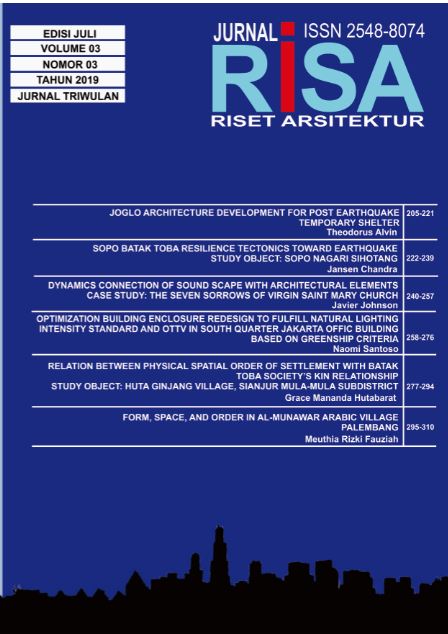FORM, SPACE, AND ORDER IN AL-MUNAWAR ARABIC VILLAGE PALEMBANG
DOI:
https://doi.org/10.26593/risa.v3i03.3337.295-310Abstract
Abstract- Arabian came to Indonesia to trade and spread Islam in Indonesia. They came by sea or river. Then they stayed and grew a family with locals on an area. That area became a settlement in a form of a village that known as Arabian Village. One of the famous Arabian Villages is Al-Munawar Arabian Village in Palembang.
Al-Munawar Arabian Village is the oldest village in Palembang. This village is still preserve its relics and culture nowadays. One of its remaining relics is eight buildings that decided as heritage buildings. These 8 buildings have their own unique hundreds of year historical background. Three buildings out of eight buildings are picked as object of research.
These buildings are land house. These houses adapted Palembang architectural style, which is pyramid house. Land house has “kekijing” in front of its house. Kekijing is a floor with ± 30-40cm terraces. Each step of floor illustrates the depth of faith. The division of land house room follows the division of Islamic residential space. The second building is stone house with Indian architectural style. The wall thickness of this house is ± 37cm. Stone house has an increase of ± 60 cm from ground level. The floor material uses tiles imported directly from Italy. The division of stone house room also follows the division of Islamic residential space. The third building is greenhouse. Greenhouse is a residential home that has changed its function to islamic school with the same shape. This house consists of two floors, the first floor uses brick wall and the second floor uses wooden wall. The division of greenhouse room doesn’t follow the division of Islamic residential space because the building is not a residential house anymore.
It’s important to study the cultural heritage buildings in this village. Considering the number of villages and traditional buildings that forgotten because of the modernization. Furthermore, there are few abandoned traditional houses and changed its shape and material became more modern.
The purpose of this study is to know the shape, room and the order of the house in Al-Munawar Arabian Village on the Palembang Musi River bank.
This is so that traditional buildings in the village will not extinct and become learning materials for all people.
The method used is qualitative method. If judged based on the purpose of the research is descriptive research. The data collecting technique are literature study, field observation and interview to the head of neighborhood in the village. This research shows that style of a building and the material that used on the objects of research are different. In addition, the division of residential space such as stone house and greenhouses are still using the division of Islamic residential space, while the greenhouse is no longer.
Key Words: Arabic village Palembang, Al-Munawar village, form, space and order.












